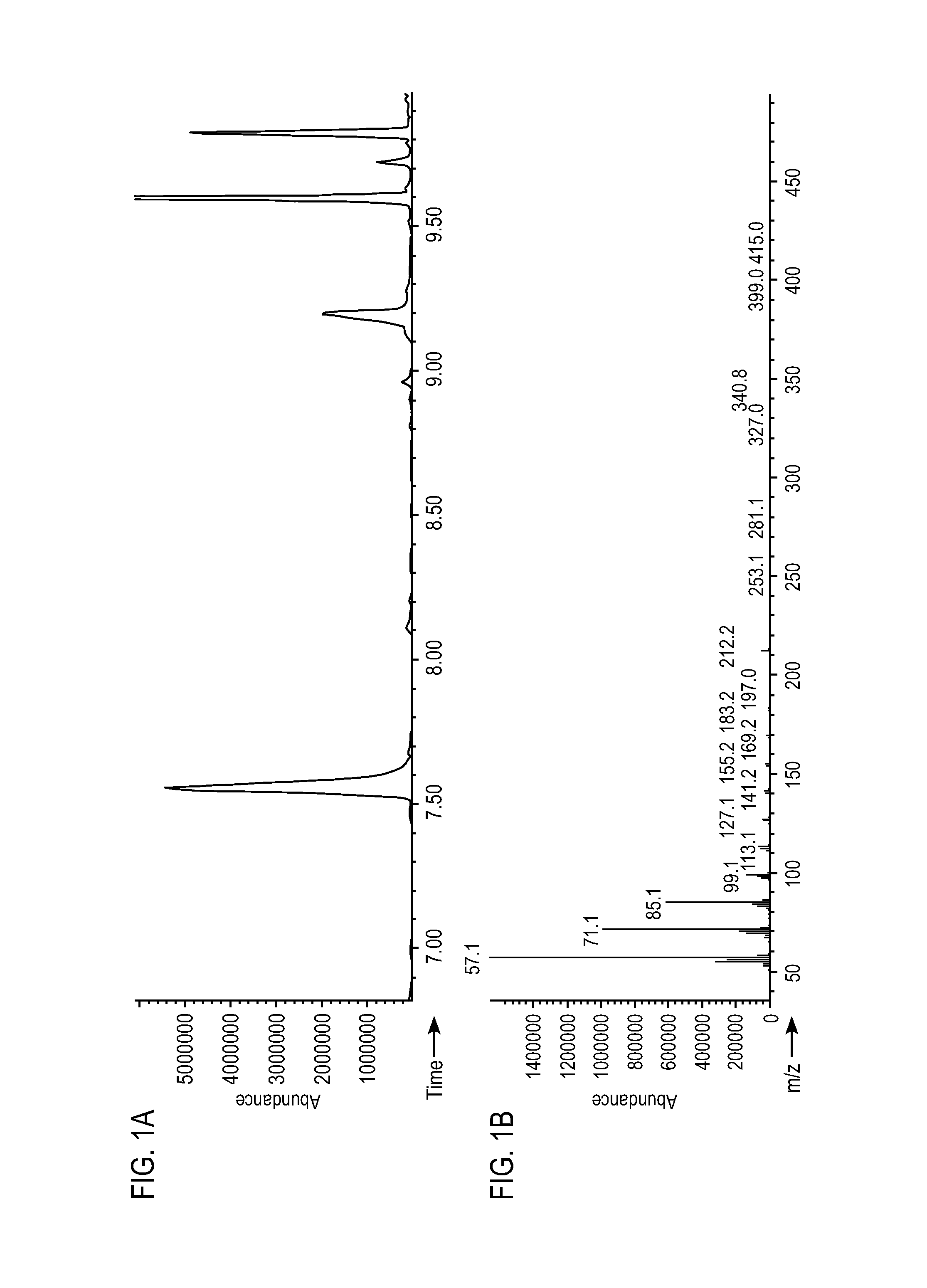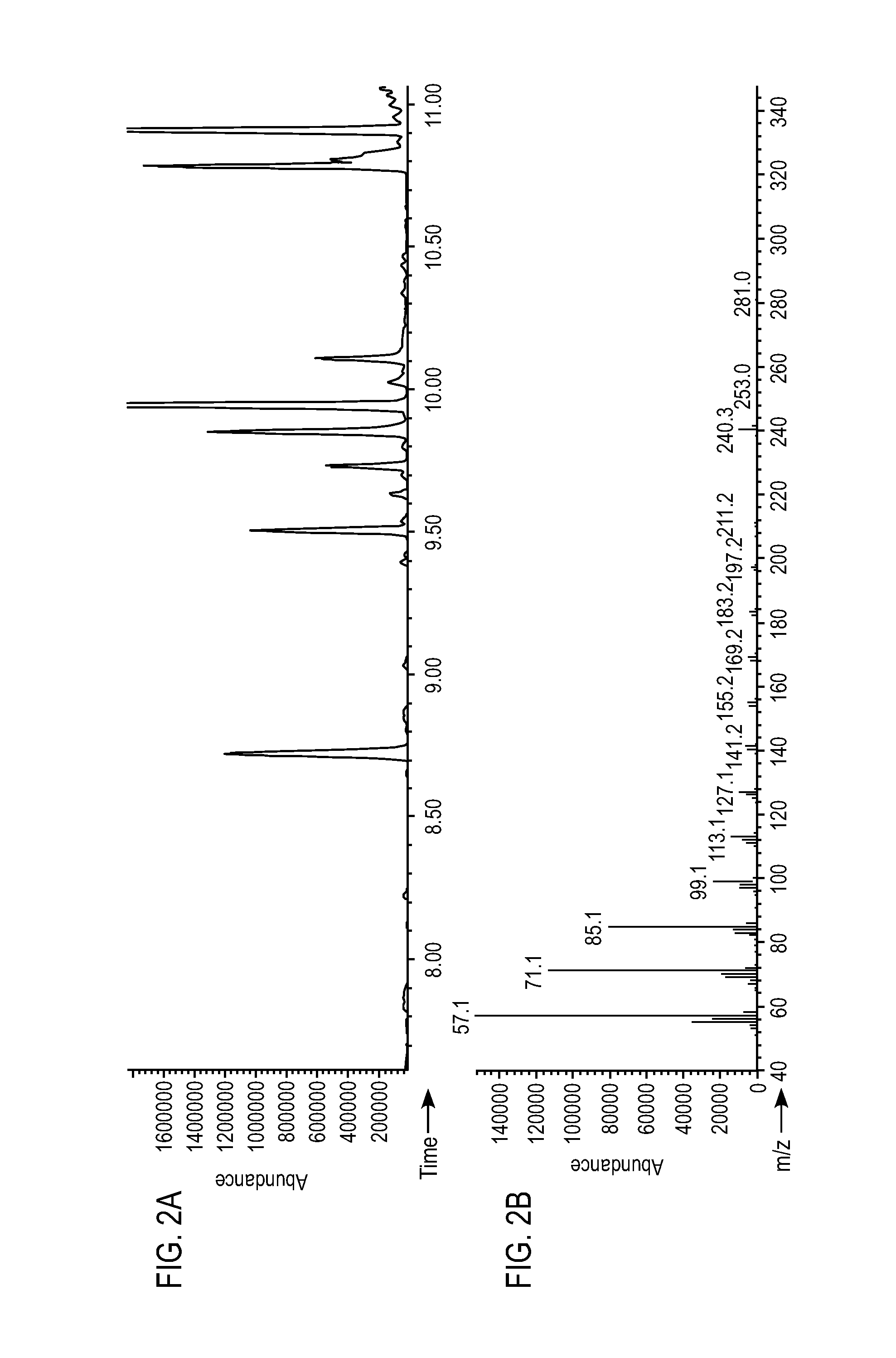Methods and compositions for producing hydrocarbons
a technology of hydrocarbons and compositions, applied in the field of methods and compositions for producing hydrocarbons, can solve the problems of petroleum exploration, high cost, and difficulty in finding petroleum sources, and achieve the effect of facilitating the movement of one or more compounds
- Summary
- Abstract
- Description
- Claims
- Application Information
AI Technical Summary
Benefits of technology
Problems solved by technology
Method used
Image
Examples
example 1
Detection and Verification of Alkane Biosynthesis in Selected Cyanobacteria
[0279]Seven cyanobacteria, whose complete genome sequences are publicly available, were selected for verification and / or detection of alkane biosynthesis: Synechococcus elongatus PCC7942, Synechococcus elongatus PCC6301, Anabaena variabilis ATCC29413, Synechocystis sp. PCC6803, Nostoc punctiforme PCC73102, Gloeobacter violaceus ATCC 29082, and Prochlorococcus marinus CCMP1986. Only the first three cyanobacterial strains from this list had previously been reported to contain alkanes (Han et al., J. Am. Chem. Soc. 91:5156-5159 (1969); Fehler et al., Biochem. 9:418-422 (1970)). The strains were grown photoautotrophically in shake flasks in 100 mL of the appropriate media (listed in Table 8) for 3-7 days at 30° C. at a light intensity of approximately 3,500 lux. Cells were extracted for alkane detection as follows: cells from 1 mL culture volume were centrifuged for 1 min at 13,000 rpm, the cell pellets were resu...
example 2
Deletion of the sll0208 and sll0209 Genes in Synechocystis sp. PCC6803 Leads to Loss of Alkane Biosynthesis
[0287]The genes encoding the putative decarbonylase (sll0208; NP—442147) (SEQ ID NO:3) and aldehyde-generating enzyme (sll0209; NP—442146) (SEQ ID NO:67) of Synechocystis sp. PCC6803 were deleted as follows. Approximately 1 kb of upstream and downstream flanking DNA were amplified using primer sll0208 / 9-KO1 (CGCGGATCCCTTGATTCTACTGCGGCGAGT) with primer sll0208 / 9-KO2 (CACGCACCTAGGTTCACACTCCCATGGTATAACAGGGGCGTTGGACTCC TGTG) and primer sll0208 / 9-KO3 (GTTATACCATGGGAGTGTGAACCTAGGTGCGTGGCCGACAGGATAGGG-CGTGT) with primer sll0208 / 9-KO4 (CGCGGATCCAACGCATCCTCACTAGTCGGG), respectively. The PCR products were used in a cross-over PCR with primers sll0208 / 9-KO1 and sll0208 / 9-KO4 to amplify the approximately 2 kb sll0208 / sll0209 deletion cassette, which was cloned into the BamHI site of the cloning vector pUC19. A kanamycin resistance cassette (aph, KanR) was then amplified from plasmid pRL27 ...
example 3
Production of Fatty Aldehydes and Fatty Alcohols in E. coli Through Heterologous Expression of Synechococcus elongatus PCC7942 orf1594
[0290]The genomic DNA encoding Synechococcus elongatus PCC7942 orf1594 (YP—400611; putative aldehyde-generating enzyme) (SEQ ID NO:65) was amplified and cloned into the NcoI and EcoRI sites of vector OP-80 (pCL1920 derivative) under the control of the Ptrc promoter. The resulting construct (“OP80-PCC7942—1594”) was transformed into E. coli MG1655 and the cells were grown at 37° C. in M9 minimal media with 1% (w / v) glucose as carbon source and supplemented with 100 μg / mL spectinomycin. When the culture reached OD600 of 0.8-1.0, it was induced with 1 mM IPTG and cells were grown for an additional 18-20 h at 37° C. Cells from 0.5 mL of culture were extracted with 0.5 mL of ethyl acetate. After sonication for 60 min, the sample was centrifuged at 15,000 rpm for 5 min. The solvent layer was analyzed by GC-MS as described in Example 1.
[0291]As shown in FIG....
PUM
| Property | Measurement | Unit |
|---|---|---|
| temperature | aaaaa | aaaaa |
| pH | aaaaa | aaaaa |
| temperatures | aaaaa | aaaaa |
Abstract
Description
Claims
Application Information
 Login to View More
Login to View More - R&D
- Intellectual Property
- Life Sciences
- Materials
- Tech Scout
- Unparalleled Data Quality
- Higher Quality Content
- 60% Fewer Hallucinations
Browse by: Latest US Patents, China's latest patents, Technical Efficacy Thesaurus, Application Domain, Technology Topic, Popular Technical Reports.
© 2025 PatSnap. All rights reserved.Legal|Privacy policy|Modern Slavery Act Transparency Statement|Sitemap|About US| Contact US: help@patsnap.com



